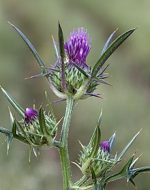 Also known as horse thistle, this annual plant is native to the semi-desert areas of the Mediterranean region and the Middle East. It is a member of the aster family, Asteraceae, that also includes daisy, yarrow, and lettuce. Plants grow up to 3′ tall and from a rosette of leaves and have erect stems that are bluish and branched above. The gray-green leaves have white veins, sharp spines on the margins and apex, and are smooth above, softly hairy below. Basal leaves are elliptical while stem leaves are more lanceolate with the uppermost ones almost reduced to spines. Purple flowerheads are .8″ across and appear singly or in terminal clusters from winter to spring. Each flowerhead is subtended by leaves modified into sharp spines. The fruit is an achene with plumose pappas hairs. Photo Credit Wikidata
Also known as horse thistle, this annual plant is native to the semi-desert areas of the Mediterranean region and the Middle East. It is a member of the aster family, Asteraceae, that also includes daisy, yarrow, and lettuce. Plants grow up to 3′ tall and from a rosette of leaves and have erect stems that are bluish and branched above. The gray-green leaves have white veins, sharp spines on the margins and apex, and are smooth above, softly hairy below. Basal leaves are elliptical while stem leaves are more lanceolate with the uppermost ones almost reduced to spines. Purple flowerheads are .8″ across and appear singly or in terminal clusters from winter to spring. Each flowerhead is subtended by leaves modified into sharp spines. The fruit is an achene with plumose pappas hairs. Photo Credit Wikidata
There are many spiny plants in the Holy Land and they are various called thistles, brambles, briers, nettles, and thorns/thorn bushes or trees. Two passages in the Bible, however, may refer to Syrian thistle, Notobaisis syrica. The passage from Isaiah, however, may refer to a combination of Syrian thistle and spotted golden thistle, Solymus maculatus, which is also common in fields and waste places throughout the Holy Land.
Job 31:40 (NIV) Job ends his plea.
” ‘then let briers come up instead of wheat and stinkweed instead of barley.’ The words of Job are ended.”
Isaiah 34:13 (NIV) God expresses his indignation against the people of all nations and tells of the desolation of the land.
“Thorns will overrun her citadels, nettles and brambles her strongholds. She will become a haunt for jackals, a home for owls.”
Syrian thistle likes full sun , and average, dry to medium moist, well-drained soil. It is often found growing along roadsides and fields, and can invade pasture land, reducing the available forage.
The genus name, Notobasis, is from the Greek words notis meaning moisture and basis meaing base or pedestal, and refers to the habitat. The specific epithet, syriaca, is the Latinized word for Syria, and efers to an area where the plant is found.